NVIDIA GeForce GTX 770 Review: The $400 Fight
by Ryan Smith on May 30, 2013 9:00 AM ESTAlthough GTX 770 is already a very high clocked part for GK104, we still wanted to put it through its paces when it comes to overclocking. Of particular interest here is actually memory overclocking, as this is the first video card shipping with 7GHz GDDR5 standard. This will let us poke at things to see just how far both the RAM itself and NVIDIA’s memory controller can go.
Meanwhile the switch to GPU Boost 2.0 for GTX 770 is going to change the overclocking process somewhat compared to GTX 680 and GTX 670. Overvolting introduces marginally higher voltages and boost bins to play with, while on the other hand the removal of power targets in favor of TDP means that we only get 106% – an extra 14W – to play with in TDP limited scenarios. Thankfully as we’ve seen we’re generally not TDP limited on GTX 770 at stock, which means our effective headroom should be greater than that.
| GeForce GTX 770 Overclocking | ||||
| Stock | Overclocked | |||
| Core Clock | 1046MHz | 1146MHz | ||
| Boost Clock | 1085MHz | 1185MHz | ||
| Max Boost Clock | 1136MHz | 1241MHz | ||
| Memory Clock | 7GHz | 8GHz | ||
| Max Voltage | 1.2 | 1.212v | ||
We’re actually a bit surprised we were able to get another 100MHz out of the GPU itself. Even without the extra overvoltage boost bin, we’re still pushing 1200MHz+ on 1.2v, which is doing rather well for GK104. Of course this is only a 9% increase in the GPU clockspeed, which is going to pale in comparison to parts like GTX 670 and GTX 780, each of which can do 20%+ due to their lower clockspeeds. So there’s some overclocking headroom in GTX 770, but as to be expected it's not a lot.
More interesting however is the memory overclock. We’ve been able to put another 1GHz on 6GHz GTX 680 cards in the past, and with the 7GHz base GTX 770 we’ve been able to pull off a similar overclock, pushing our GTX 770 to an 8GHz memory clock. The fact that NVIDIA’s memory controller can pull this off is nothing short of impressive; we had expected there to be some headroom, but another 14% is beyond our expectations. At this clockspeed the GTX 770 has a full 256GB/sec of memory bandwidth, 33% more than both a stock GTX 680 and the 384-bit GTX 580. Of course we’ll see if GTX 770 can put that bandwidth to good use.
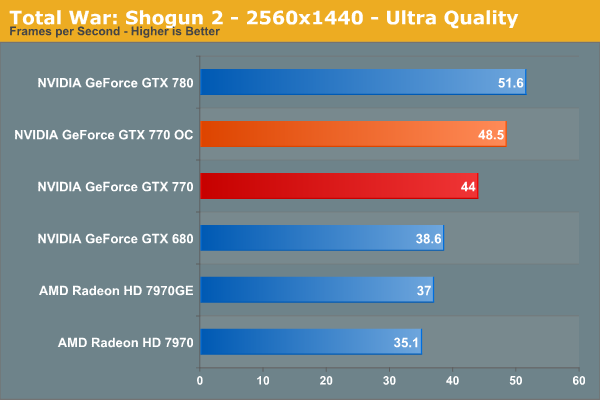
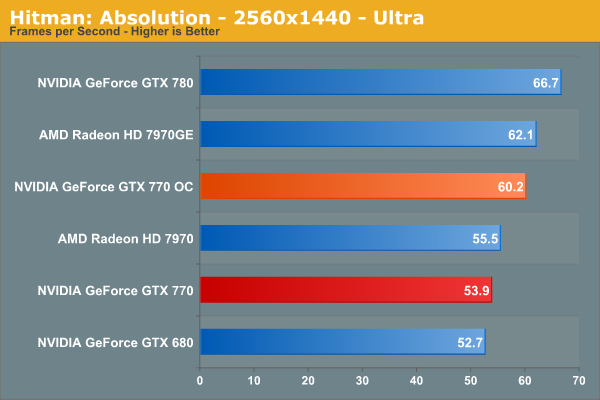
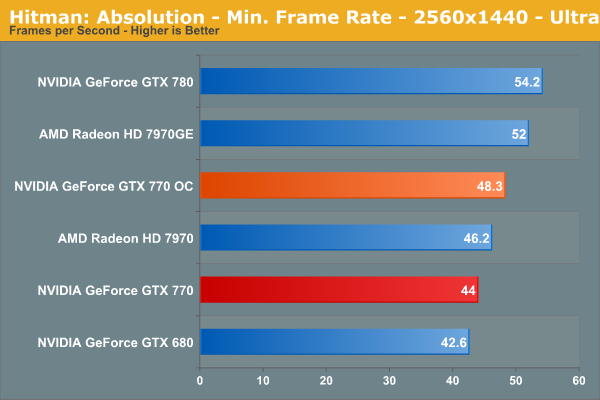
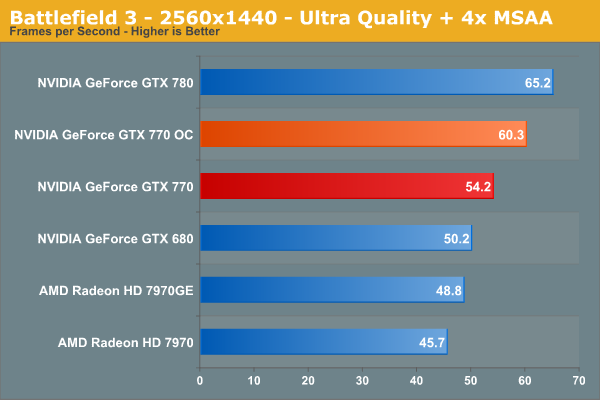
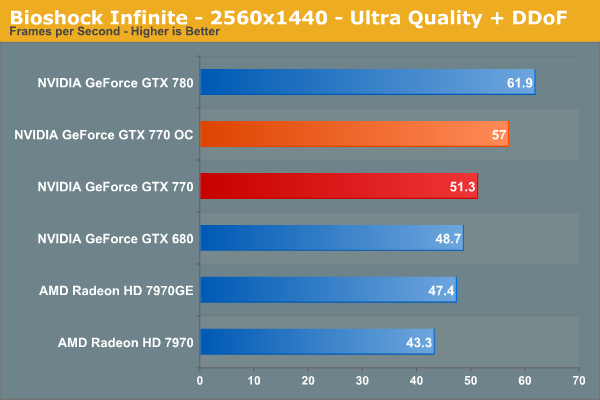
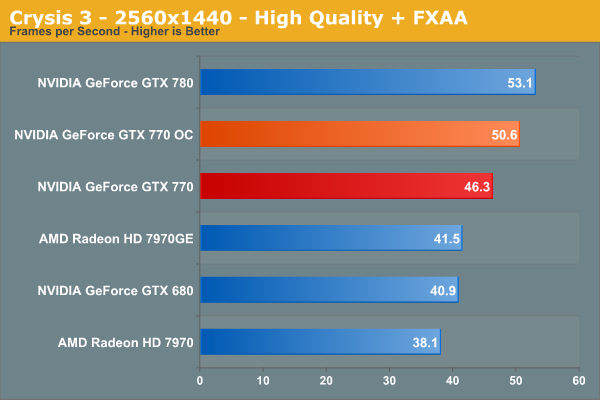
The end result of our overclocking efforts nets a very consistent 9%-12% increase in performance across our games. 9% is the upper bound for improvements due to GPU overclocking, so anything past that means we’re also benefitting from the extra memory bandwidth. We aren’t picking up a ton of performance from memory bandwidth as far as we can tell, but it does pay off and is worth pursuing, even with the GTX 770’s base memory clock of 7GHz.
Overall overclocking can help close the gap between the GTX 770 and 7970GE in some games, and extend it in others. But 10% won’t completely close the gap on the GTX 780; at best it can halve it. GTX 780’s stock performance is simply not attainable without the much more powerful GK110 GPU.
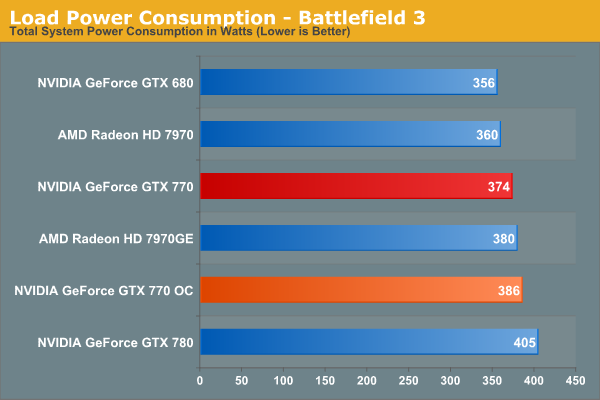
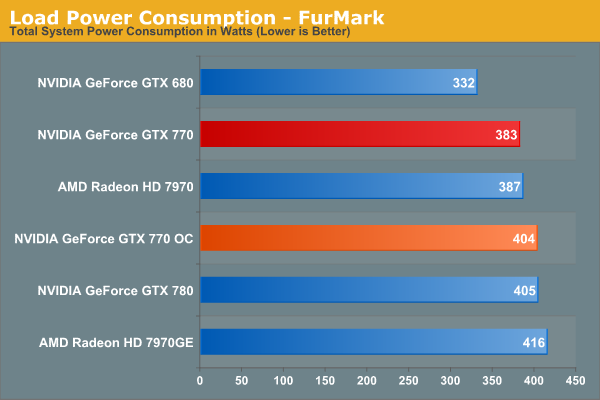
Moving on to power consumption, we can see that the 106% TDP limit keeps power usage from jumping up by too much. In Battlefield 3 this is a further 12W at the wall, and 21W at the wall with FurMark. In games this means our power usage at the wall is still below GTX 780, though we’ve equaled it under FurMark.
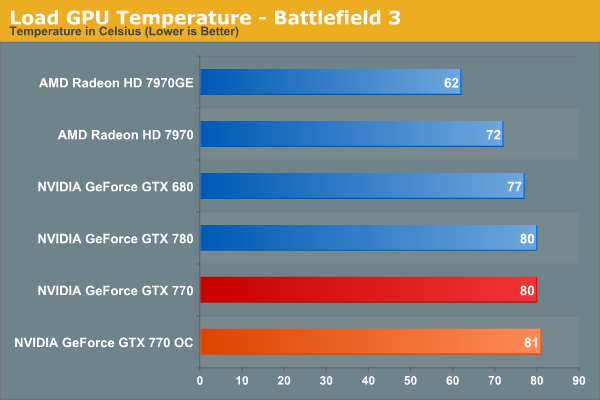
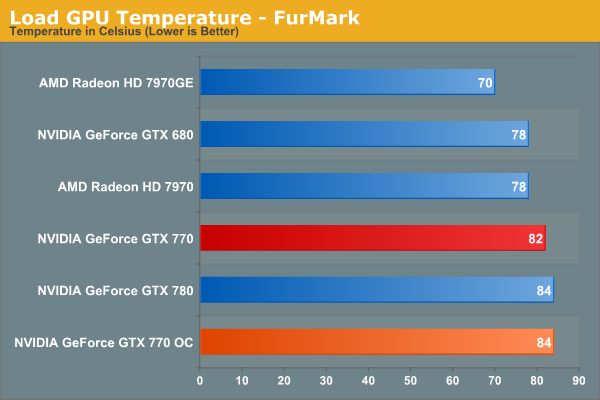
The fan curve for GTX 770 appears to be identical to that of GTX 780. Which is to say the fan significantly ramps up around 84C, keeping temperatures in the low-to-mid 80s even though GPU Boost 2.0 is allowed to go up to 95C.


Finally for fan noise, we see a small increase under Battlefield 3, and no change under FurMark. 1.5dB louder under Battlefield 3 puts noise levels on par with the GTX 780, sacrificing some of GTX 770’s abnormally quiet acoustics, but still keeping noise below the 50dB level. Or to put this another way, the performance gains for overclocking aren’t particularly high, but then again neither is the cost of overclocking in terms of noise.










117 Comments
View All Comments
JDG1980 - Thursday, May 30, 2013 - link
TechPowerUp ran tests of three GTX 770s with third-party coolers (Asus DirectCU, Gigabyte WindForce, and Palit JetStream). All three beat the GTX 770 reference on thermals for both idle and load. Noise levels varied, but the DirectCU seemed to be the winner since it was quieter than the reference cooler on both idle and load. That card also was a bit faster in benchmarks than the reference.That said, I agree the build quality of the reference cooler is better than the aftermarket substitutes - but Asus is probably a close second. Their DirectCU series has always been very good.
ArmedandDangerous - Thursday, May 30, 2013 - link
This article is in desperate need of some editing work. Spelling and comprehension errors throughout.Nighyal - Thursday, May 30, 2013 - link
I asked this on the 780 review, and it seems like it might be even more interesting for the 770 considering Nvidia's basically threw more power at a 680, but a performance per watt comparison would be great. If there was something that clearly showed the efficiency of each card in a way (maybe using a fixed work load) it would be interesting to see. Especially when compared to similar architectures or when comparing AMD's efforts with the GHz editions.ThIrD-EyE - Thursday, May 30, 2013 - link
Since when did 70-80C temperatures become acceptable? I had been looking to upgrade my MSI Cyclone GTX 460 which would never hit higher than 62C and I got a great deal on 2 560TIs for less than half the cost of them new. I have run them in single card and SLI; I see 80C+ when I run an overclock program like MSI Afterburner. I use a custom fan profile to bring the temps down to 75C or less at higher fan speed, but still in reasonable noise levels. It's still not quite enough.All these video cards may be fine at these temperatures, but when you are sitting next to the case and there is 80C being pumped out, you really feel it. Especially now with Summer heat finally hitting where I live. My $25 Hyper212+ keeps my OC'ed i7 2600k at a good 45-50C when playing games. I would buy aftermarket coolers if they were not going to take up 3 slots each (I have a card that I need, but would have to be removed.) and didn't cost nearly as much as I paid for the cards.
AMD, NVIDIA and card partners need to work on bringing temperatures down.
quorm - Thursday, May 30, 2013 - link
lower temperature readings do not mean less heat produced. better cooling just moves the heat from the GPU to your room more efficiently.ThIrD-EyE - Thursday, May 30, 2013 - link
The architecture of these video cards were obviously made for performance first. That does not mean they can't also work on lowering power consumption to lower the heat produced. One thing that I've found to help my situation is to set all games to run at 60fps without vsync if possible, which thankfully is most fo the games I play. Some games become unplayable or wonky with vsync and other ways of limiting fps without vsync, so I just deal with the heat from no fps limits.I hope that the developers of console ports from PS4 and Xbox One put in an fps limit option like Borderlands 2 if they don't allow dev console access.
MattM_Super - Friday, May 31, 2013 - link
Although its not currently accessible from the driver control panel, Nvidia drivers have a built in fps limiter that I use in every game I play (never had any issues with it). You can access it with NvidiaInspector.DanNeely - Thursday, May 30, 2013 - link
Since 70-80C has always been the best a blower style cooler can do on a high power GPU without getting obscenely loud, and blowers have proven to be the best option to avoid frying the GPU in a case with horrible ventilation. IOW about when both nVidia and ATI adopted blowers for their reference designs.JPForums - Thursday, May 30, 2013 - link
70C-80C temperatures became acceptable after nVidia decided to release Fermi based cards that regularly hit the mid 90Cs. Since then, the temperatures have in fact come down. Of course, they are still high for my liking and I pay extra for cards with better coolers (I.E. MSI TwinFrozer, Asus DirectCU). That said, there is only so much you can do when pushing 3 times the TDP of an Intel Core i7-3770K while cooling it with a cooler that is both lighter and less ideally formed for the task (Comparing some of the best GPU coolers to any number of heatsinks from Noctua, Thermalright, etc.). Water cooling loops work wonders, but not everyone wants the expense or hassle.Rick83 - Friday, May 31, 2013 - link
The higher the temperatures, the less fan speed you need, because you have higher delta-theta between the air entering the cooler and the cooling fins, which results in more energy transfer at less volume throughput.Obviously the temperature is a pure function of the fan curve under load, and has very little to do with the actual chip (unless you go so far down in energy output, that you can rely on passive convection).